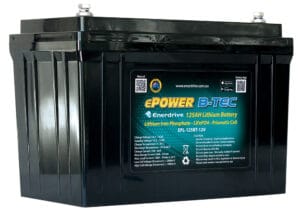The latest lithium-ion batteries have many advantages over traditional lead-acid batteries for RVs, as Bill Savidan explains.
Every household has growing numbers of rechargeable batteries powering an increasingly diverse range of items: electronic equipment, household appliances, gardening and handyman tools. The most recent entrants to the rechargeable battery market is the lithium-ion family of batteries. They have endured the bad press of starting fires in aircraft and laptops, and have come out strongly on the other side. They are now lining up to replace lead-acid batteries and their derivatives in RVs.
Both lead-acid and lithium-ion batteries create electricity as the end product of anode/cathode/chemical reactions within the battery cells. Externally, the lead-acid and lithium-ion battery boxes look the same, but inside they are quite different.
Lead-acid battery cells are a series of vertical lead plates immersed in an electrolyte bath in a battery box. Lithium-ion battery cells are different. They are either cylindrical in shape and similar in size to AA torch batteries, or rectangular, like camera batteries (aka prismatic). They come packed inside a battery box. Along with the cells are a host of other items that keep the battery safe and efficient: temperature sensors, a voltage converter, a regulator circuit, a voltage tap monitoring each cell’s energy capacity, a notebook connector monitoring power and information flow, and a computer that manages the entire process to ensure the fullest charge in the shortest time possible. These items are collectively known as the Battery Management System (BMS) and without them the battery would not function.
Lead-acid batteries come in different forms (AGM, gel and lead-calcium). But they all rely on the same chemical reaction to create electricity. Again, the lithium-ion family is different. Each can have different characteristics depending on the materials used to make the electrodes, and the type of electrolyte used.
Early varieties of commercially successful lithium-ion batteries had lightweight lithium and carbon electrodes. They had significant advantages over other rechargeable batteries of the time. Lithium is highly reactive, so it stores a lot of energy. It is ‘energy-dense’. A lithium-ion battery can store 150 watt-hours of electricity in a single kilogram of battery. Compare that with nickel-metal hydride, 80 watt-hours per kilogram, or a lead-acid battery, 25 watt-hours per kilogram. Quite a big difference!

Other advantages include: a low rate of charge loss, of around 5% of charge per month when idle; they tolerate being partly discharged or partly recharged; and have a total life of hundreds of charge/discharge cycles.
But they had negative qualities too: a short life span of two to three years with high temperatures causes them to degrade faster, and a total discharge would ruin the battery altogether.
Today, the lithium-iron phosphate (LiFePO4) battery type is the one best suited for RVs as it is the safest in the lithium-ion family. LiFePO4 is a non-toxic material. Although not quite as energy-dense as the older batteries were, LiFePO4 batteries are also more stable and live longer. The phosphate-based technology they use is the reason for this thermal and chemical stability. LiFePO4 cells don’t catch fire if they are mishandled while charging or discharging, and they are more stable if overcharged or they short-circuit. They resist high temperatures without breaking down. Their battery cells do contain a small quantity of electrolyte that is essential for the electricity creating chemical process, but it’s not a fire hazard like the electrolyte in the older batteries. Fire risk in the LiFePO4 cells is extremely low, even in harsh circumstances.
Battery life is measured by the number of charge/discharge cycles a battery can tolerate. LiFePO4 battery life is around 2000 plus charge/discharge cycles. That’s over five years’ service if discharged/recharged every day. And LiFePO4 batteries don’t have ‘shelf-life issues’. They’re in it for the long haul.
The recommended maximum discharge of a LiFePO4 battery in normal service is 80% of its total capacity, but it can handle 100% discharge occasionally without serious harm. In practical terms one 125 amp/hr LiFePO4 battery could supply 100 amp/hrs without exceeding an 80% maximum discharge. It takes two 100amp/hr lead-acid batteries (50% max discharge) to produce the same 100 amp/hrs. Do the maths.
Taking the electricity out of the battery is only half the story. To do the same things over again, power must be restored to the battery. The lithium battery is a winner here as well. If the power is available, it can recharge quicker than a lead-acid battery, but only if the charging equipment (battery charger, solar panel and solar regulator) can supply enough energy to meet the battery’s needs.
Although a LiFePO4 battery can be charged using most standard lead-acid chargers, one with the correct lithium charge algorithm is the best option for maximum performance and lifespan of any lithium battery.
If you want to know more, search online or visit YouTube. You’ll see how easy it is to make lithium-ion batteries. Nothing demystifies a subject quicker than seeing it being dis-assembled and reassembled on a video screen.






